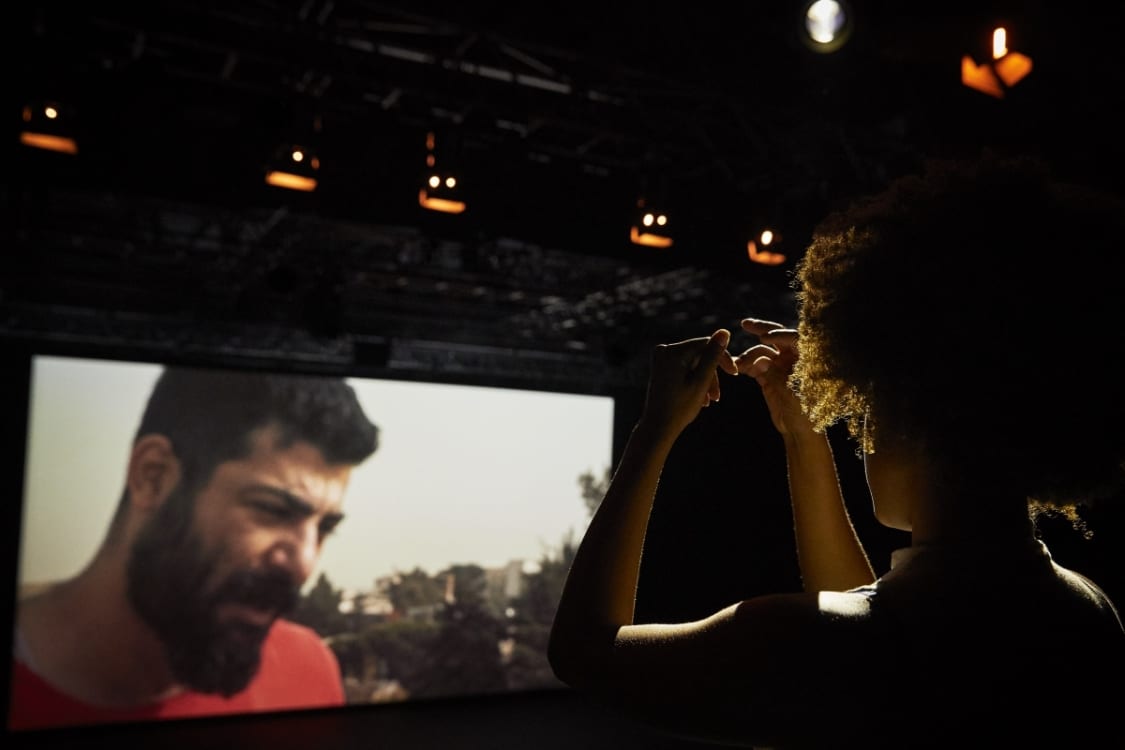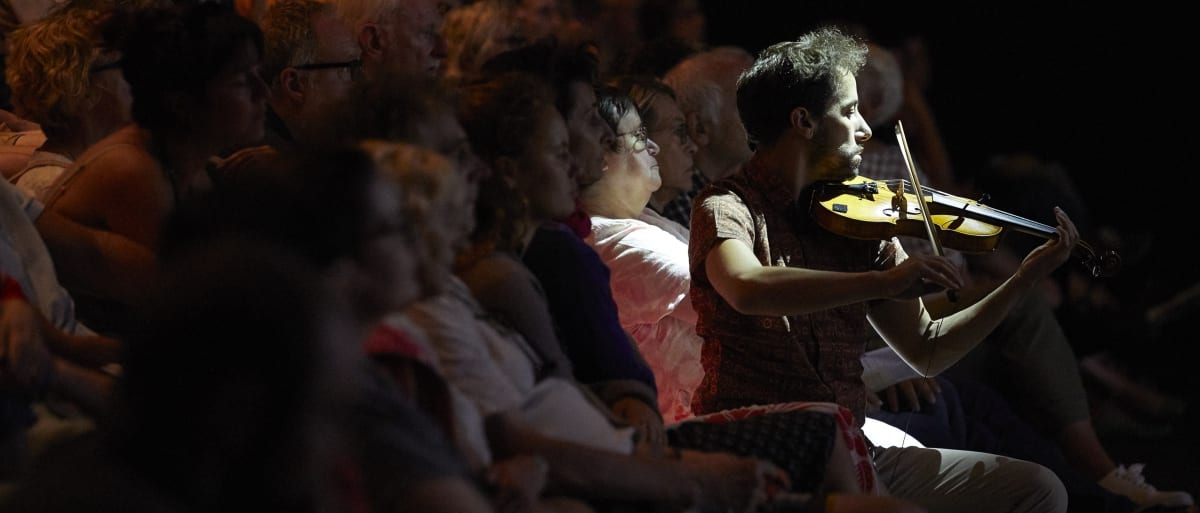The Lingering Now is one of the most promising plays that you could hope for in the “In” Festival d’Avignon: it is described as firmly politically engaged and a new form of hybrid between theatre and cinema. Brazilian director Christiane Jatahy, who talks to the audience before and after the show, filmed various situations of modern exiles and refugees throughout the world: Palestine, Greece, Lebanon/Syria, South Africa, or even her own country in the Amazon rainforest. She wanted them to tell their stories of exile, recite or “play” parts of Homer’s Odyssey, or even just capture moments of their lives.
Before the show begins, when joining your seat, you can watch images of this film on a big screen. The modest scenography consists of this big screen and of two control tables on the side of the stage where the director and artistic assistant Thomas Walgrave edits the images and sounds live. Even though the beginning of the show is only documentary, three musicians who were hidden in the audience begin in turn to accompany the music heard from what has been filmed.
That’s how we are introduced to the core of Jatahy’s mise en scène: creating a “third space” between the images she filmed and the audience, a meeting place between you and the exiles. After the guitar and the violin, the voice of a woman right behind me, illuminated by a spotlight, creates a real orchestra in the audience. Furthermore, what you see on screen invites you to look at her in the audience: the refugees are looking off-screen, a little above the camera, so that they feel like they are listening to what the actress is singing live in the grandstand.
Unfortunately that interesting idea is quickly simplified into a caricature. A scene of dance, started in the documentary, continues with the actors and actresses hidden within the audience. They are filmed live and their images are being projected on the big screen and edited in between images from South Africa or the Middle East. Part of the real audience is applauding and standing up…and the overall show feels rather fake and a million miles away from the harsh life stories told a few minutes before. Even how the dancers are filmed seems fake: the low-angle shot and the close-up on isolate them from the real audience, which is kept off screen.

One other interesting moment turned out to be disappointing. Yara Ktaish, young woman and syrian refugee who is now living in Lebanon, is filmed at night near a road. The atmosphere is dark, we can barely see her face, and the few lights that you can see are the ones from the cars passing by behind the camera. This shot lasts a few minutes, more than most of the shots from the documentary, and the life story of Yara who fled torture and political persecution is detailed by precise words and real emotion from her voice.
Then Yara is illuminated by a spotlight. Not in the documentary, but she’s been hidden in the audience since the beginning of the show. She continues her life story, her face in close-up now projected on the big screen. But her moving testimony is no longer the fragile heartbreaking moment of her in the darkness of the night. Her voice is more assured, it feels rehearsed and it is very precise, as you can verify by the French subtitles that perfectly match what she says. She absorbed her own life story her own image and with the help of the director she managed to tell it to a big audience. The documentary turned into theatre.
The image of Yara, filmed in the past, surged into the present of the show with Yara being a member of that audience. That transposition from image to reality is only a short part of the show which lasts two hours. It is submerged in the multiple life stories and ideas of mise en scène, which turn out to be gimmicks. One of these gimmicks turns out to be actors and actresses telling the story, resulting in a brouhaha where you could not understand clearly each story. That’s one of the major issues of the show: by multiplying the viewpoints, the characters, the places, the political situations, and the gimmicks, you don’t have the time to think and really understand each story or what is the link between them.
Despite the best intent, the play fails to deliver what it promised. What does it really create ? The whole play feels more like a channel hopping or zapping between situations of exile. The hybrid device designed by Christiane Jatahy creates superficial links and more spectacle or entertainment than a real documentary show. How did I understand the mechanism of terror, oppression, or exile ? Vibrant and lively, the show lacks focus. The director wants to embrace and include almost every single story she encountered, even her own (her father was killed by the Brazilian dictator when she was only a child, her grandfather died when his plane crashed in the Amazon rainforest) or what happened to her assistant’s family in the 20th century. While is it never miserabilist or voyeuristic, and raises interesting questions about the links between theatre and cinema, past and present, storytelling and narration, The Lingering Now feels like it doesn’t deliver the political and hybrid Odyssey we could have hoped for.

